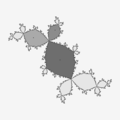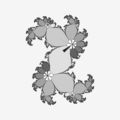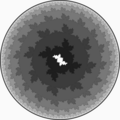Fractals/target set
Definition
Dynamical plane is divided into
- Fatou set
- Julisa set
Fatou set consist of one or more basins of attraction to the attractor.
Each basin of attraction has one or more critical points which fall into periodic obit ( attractor)
- polynomial map
-
repelling case: disconnected Julia set and only one basin ( superattractin with period 1: basin of infinity)
-
2 basins each with only one component
-
2 basins: exterior ( 1 component) and interior: consist of infinitely many components (attracting case)
-
2 basins: exterior and interior. Exterior consist of only one component ( superattracting with period 1). Interior consist of infinitely many components. Imediate basin of attraction consist of 3 components cointaining period 3 cycle
-
Parabolic attractor belongs to Julia set
Target set
- is a trap for forward orbit
- is a set which captures any orbit tending to attractor (limit set = attracting cycle = fixed / periodic point).
Types
Criteria for classifications: one can divide it according to :
- attractors ( finite or infinite)
- dynamics ( hyperbolic, parabolic, elliptic )
- shape ( bailout test)
- destination
- decomposition of target set: binary decomposition ( BDM), angular decomposition,
by attrators
For infinite attractor
- Target set is an arbitrary set on dynamical plane containing infinity and not containing points of Filled-in Fatou sets.
- For escape time algorithms target set determines the shape of level sets and curves. It does not do it for other methods.
- For escaping to infinity points ( basin of infinity = exterior of Julia set) it is exterior of circle with center at origin and radius =ER :
Radius is named escape radius ( ER ) or bailout value. Radius should be greater than 2.
Infinity:
- for polynomials infinity is superattracting fixed point. So in the exterior of Julia set (basin of attraction of infinity) the dynamics is the same for all polynomials. Escaping test ( = bailout test) can be used as a first universal tool.
- for rational maps infinity is not a superattrating fixed point. It may be periodic point or not.
For finite attractors
File:Quadratic Julia set with Internal level sets for internal ray 0.ogv
For finite attractors see: target set by basin
See :
- Internal Level Sets
- Binary decomposition
- Tessellation of the Interior of Filled Julia Sets by Tomoki KAWAHIRA [1]
by the dynamics
File:Target set for internal ray 0.ogv
Here
- is the last iteration of critical orbit
- is the center of the trap ( circle shape)
- is periodc / fixed point ( alfa fixed point)
Trap is the circle with center and radius = AR
repeling case
- Stability index = cabs(multiplier) > 1.0
- periodc / fixed point ( alfa fixed point) is repelling = ther is no interior of Julia set
attracting but not supperattracting case
- and all points are inside Julia set
- Stabilitu index: 0.0 < cabs(multiplier) < 0.0
Elliptic case

For the elliptic dynamics, when there is a Siegel disc, the target set is an inner circle
Supperattracting case
Attractors:
- Infinity is allways superattracting for forward iteration of polynomials. Target set here is an exterior of any shape containing all point of Julia set (and its interior)
- finite asttractors can also be superattracting, when parameter c is a center ( nucleus) of hyperbolic component of Mandelbrot set
In case of forward iteration target set is an arbitrary set on dynamical plane containing infinity and not containing points of filled Julia set.
supperattracting case : here
- so one have to set AR manually, like AR = 30*PixelWidth
- Stabilitu index = cabs(multiplier) = 0.0
- Center of attracting basin is
Parabolic case: petal
- periods 1-2 and circle target
-
fixed point belongs to Julia set and to the boundary of the trap ( here circle)
- periods greater than 2 so triangle targets
-
triangle trap in parabolic case for t = 1/30
In parabolic case trap can be for
In the parabolic case target set should be inside the petal
parabolic case for child period 1 and 2 the target set can have circle shape :
- one should:
- compute AR
- change trap center to midpoint between attracting fixed point zp and the last iteration of critical orbit zn to get:
- Stabilitu index cabs(multiplier) = 1.0
- here
Fof child periods > 2 petal can be triangle fragment of the circle around fixed point for the parent period.
by destination
It is important for parabolic case:
- for Fatou basin ( color depends on the target set): circle around fixed point = trap for interior
- for component of Fatou basin ( color proportional to to iteration modulo period) - triangle fragment of above circle = biggest triangle (zp, zprep, -zprep) = trap for components
- for level set of Fatou basin ( color proportional to last iteration number ) = trap for components
- for BDM or parabolic checkerboard : 2 smaller triangles (zp, zprecr, zcr) and (zp, zcr, -zprecr) = traps for BD
-zprecr zf zcr zprecr
where
- p is a period
- zf = fixed point ( here period = 1)
- zcr = critical point z=0
- zprecr = precritical point = preimage of critical point: . Note that inverse function is multivalued so one should choose the proper preimage
unsigned char ComputeColorOfFatouBasins (complex double z)
{
int i; // number of iteration
for (i = 0; i < IterMax; ++i)
{
// infinity is superattracting here !!!!!
if ( cabs2(z) > ER2 ){ return iColorOfExterior;}
// 1 Attraction basins
if ( cabs2(zp-z) < AR2 ){ return iColorOfInterior;}
z = f(z); // iteration: z(n+1) = f(zn)
}
return iColorOfUnknown;
}
unsigned char ComputeColorOfFatouComponents (complex double z)
{
int i; // number of iteration
for (i = 0; i < IterMax; ++i)
{
// infinity is superattracting here !!!!!
if ( cabs2(z) > ER2 ){ return iColorOfExterior;}
//1 Attraction basins
if ( cabs2(zp-z) < AR2 )
{ return iColorOfBasin1 - (i % period)*20;} // number of components in imediate basin = period
z = f(z); // iteration: z(n+1) = f(zn)
}
return iColorOfUnknown;
}
unsigned char ComputeColorOfLSM (complex double z)
{
//double r2;
int i; // number of iteration
for (i = 0; i < IterMax_LSM; ++i)
{
if ( cabs2(z) > ER2 ){ return iColorOfExterior;}
//1 Attraction basins
if ( cabs2(zp-z) < AR2 ){
return i % 255 ;
}
z = f(z);
}
return iColorOfUnknown;
}
by the shape
- circle
- square
- Julia set
- p-norm disk
Exterior of circle
This is typical target set. It is exterior of circle with center at origin and radius =ER:
Radius is named escape radius (ER) or bailout value.
Circle of radius=ER centered at the origin is:
For escaping to infinity points ( basin of infinity = exterior of Julia set) it is exterior of circle with center at origin and radius =ER :
Radius is named escape radius ( ER ) or bailout value. Radius should be greater than 2.
For finite attractors it is interior of the circle with center at periodic point
For parabolic periodic points
- it is called a petal
- petal is interior of the circle
- center of petal circle is equal to midpoint between lat iteration and parabolic periodic point
- parabolic periodic point belongs to Julia set
-
parabolic case
Exterior of square
Here target set is exterior of square of side length centered at origin
Julia sets
Escher like tilings is a modification of the level set method ( LSM/J). Here Level sets of escape time are different because targest set is different. Here target set is a scalled filled-in Julia set.
For more description see
- Fractint : escher_julia
- page 187 from The Science of fractal images by Heinz-Otto Peitgen, Dietmar Saupe, Springer [2]
-
Basilica
-
c = -1.24
-
Douady Rabbit
p-norm disk
See also












